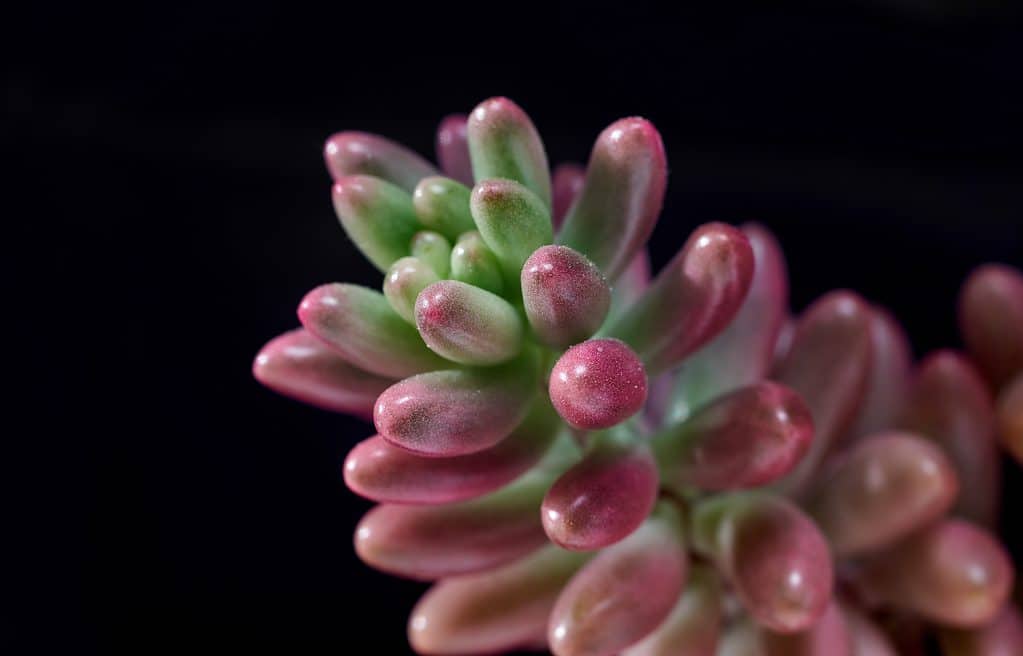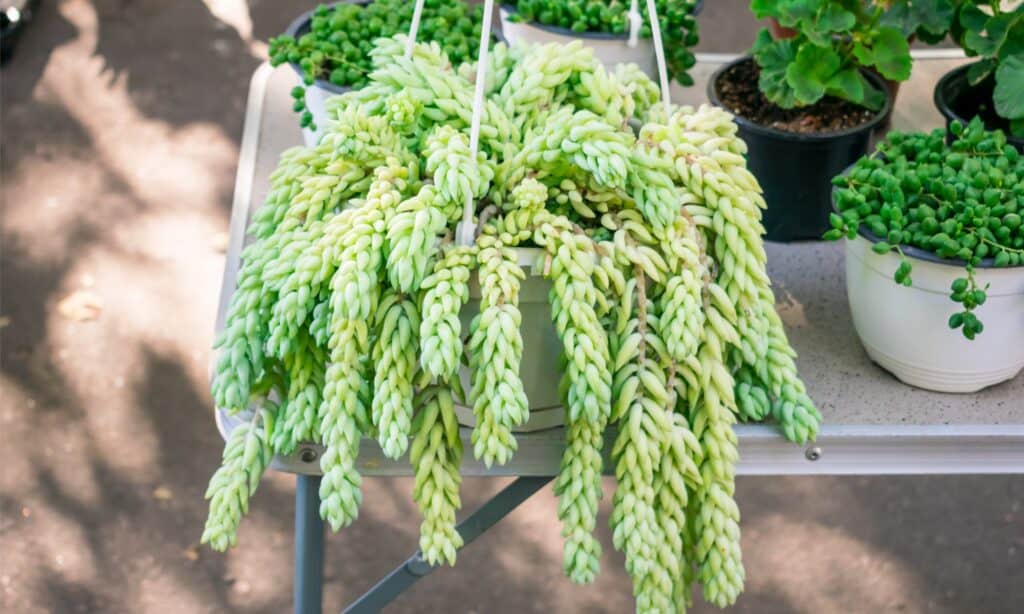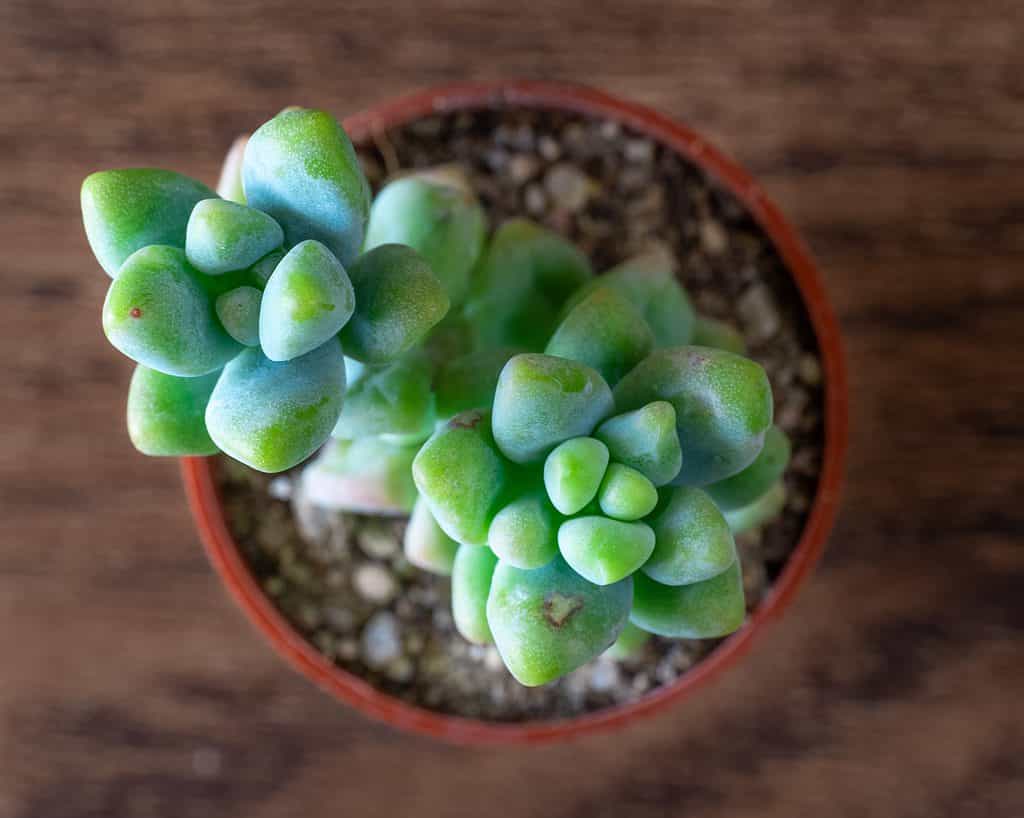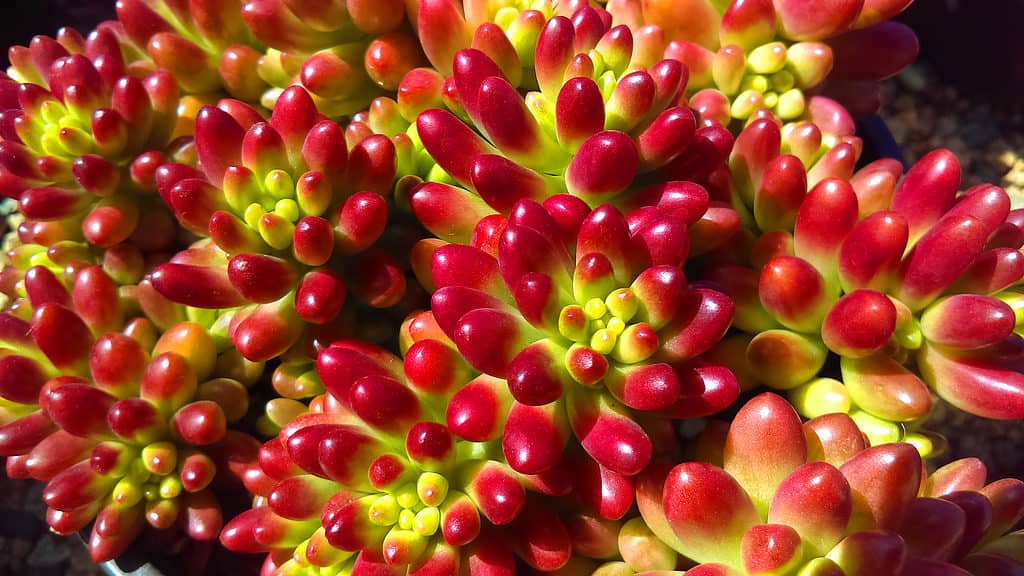Maybe you dreamed of growing your own jelly beans as a kid. Good news…you can! (You don’t want to eat these jelly beans, though. They are toxic.)
The jelly bean succulent is an adorable little plant with plump leaves that look like, you guessed it, jelly beans.
Also known as the “pork-and-beans succulent” or “Christmas cheer,” jelly bean plants are Sedum succulents, a large genus of different succulent species.
These succulents are versatile and adaptable. They can be grown in outdoor gardens or indoor containers. They make lovely hanging plants, as well.
There are several different types of jelly beans, each with its own distinctive appearance. You’re sure to find one (or more) that you’ll love!
1. Green Jelly Bean
The green jelly bean is the most common type of jelly bean succulent.
It is an evergreen perennial succulent plant. The leaves are green, but with adequate sunlight, they will also display shades of red. The plant is not receiving enough daily sunshine if there is no red on the leaves.

The green jelly bean has red tips when it receives enough sunlight.
©Sonia Bonet/Shutterstock.com
2. Pink Jelly Bean
Also known as the “Aurora jelly bean” plant, this succulent’s stunning red/pink leaves, combined with green and cream hues, are a real showstopper.
It can thrive in containers or outdoor gardens.

The pink jelly bean plant with pink and green leaves.
©Kateryna Puchka/Shutterstock.com
3. Blue Jelly Bean
Also knowns as many fingers, the blue jelly bean succulent features blue-green foliage shaped like fingers. When the plant receives adequate sunlight, it will also display a pink hue around the leaf tips.
Blue jelly beans are a larger succulent. They top out around 12 inches tall.

The blue jelly bean plant has leaves that look like fingers.
©Celine Kwang/Shutterstock.com
4. Donkey’s Tail
This succulent goes by several names, including “burro’s tail,” “horse’s tail,” and “lamb’s tail.”
The donkey’s tail features rows of fleshy, jelly bean-shaped leaves that are green in color.
It can be grown as a houseplant or outdoors, but it is especially loved as a hanging plant. The foliage trails out of the hanging basket beautifully.

The Donkey’s tail jelly bean plant loves full sunlight.
©iStock.com/Iryna Imago
Caring for Your Jelly Bean Succulent
While these jelly beans are diverse in appearance, they all require similar and very minimal care. That makes them the perfect succulent plants for both beginning and veteran gardeners.
Let’s talk about how you can grow your very own jelly beans!
Sunlight
All jelly beans require lots of bright sunshine.Therefore, sixx hours a day is needed for them to achieve maximum color and vitality.
Some shade is needed from the harsh sun of mid-afternoon, though. The leaves can scorch, especially on particularly hot days.
Soil Type
Jelly beans thrive in nutrient-poor soil. Most rocky or sandy soils will work as long as there is adequate drainage.
As with most other succulents, jelly beans need soil that drains exceedingly well. If the soil holds too much moisture, it can lead to root rot which will kill the plant.
When growing jelly beans in containers, using a prepackaged cactus soil mix is a good choice. In addition, you can add peat or perlite to increase drainage effectiveness.
Also, consider using clay or terracotta pots since they wick away excess moisture from the soil.

A Donkey’s tail succulent planted in a well-draining potting mix.
©LoCrew/Shutterstock.com
Water
When planted outdoors, established jelly bean succulents rarely need watering.However, youu may need to soak the plants occasionally during drought conditions. Under normal circumstances, though, they rarely need watering since water is stored in their plump leaves.
When growing your jelly bean indoors, you will obviously need to water it since it has no rain access. But remember that overwatering is a killer for succulents. If the top inch of soil is not completely dry, it’s not time to water the plant.
When the soil dries out, soak the roots of the plant. Don’t pour water directly onto the leaves, as that can lead to rot.
As with all succulents, make sure there are drainage holes in the container.
Placement
Jelly beans are not cold-hardy plants. They are native to Mexico and love warm, dry conditions.
Temperatures below 40°F can kill these succulents. If you live in Zone 8 or below, plant your jelly beans in containers that can be brought inside during cold weather. You can also choose to grow them as year-round houseplants.
When grown indoors, jelly bean succulents do best with access to a window where they can bask in the morning sun for hours. If this is not possible, you can supplement by using grow lights.
Propagation
Jelly bean succulent plants are easily propagated through stem or leaf cuttings.
For stem cuttings, use a clean knife or scissors to cut a stem from the base of the mother plant. Set the cutting aside for 1-2 days to allow it to callus over, then plant the stem in a new container with the cutting side down.
For leaf cuttings, cut a healthy leaf from the succulent. A partial leaf will not work. Make sure to take the entire leaf.
Set the leaf aside and allow it to dry. Once dry, place it on the soil mix.
Whether you use leaf or stem cuttings, keep the soil moist until roots develop. This should only take a couple of weeks.
Tug very gently on the cutting. If you feel some resistance, the roots are taking hold, and you can begin caring for the daughter plant just as you do the mother plant.
Common Problems
If you haven’t noticed by now, the most common problem with jelly bean succulents is overwatering. Jelly beans, like most other succulents, are susceptible to root rot and stem rot.
Jelly beans are also vulnerable to common succulent pests, such as scale and mealybugs. These insects love to feed on a succulent’s juices, which can damage or even destroy the plant.
If these pests are present on your jelly bean plant, dip a cotton swab in rubbing alcohol and apply it to all the visible pests on the plant. You can also dilute the rubbing alcohol with water and mist the plant with a spray bottle.
Insecticidal soap is also an effective treatment, as is neem oil. Both are organic and safe for your plants.

Extreme close-up of a mealybug on a green leaf.
©AjayTvm/Shutterstock.com
Fungus gnats can also be problematic. These gnats look like tiny black or brown flies or mosquitoes. If these gnats are present, you can almost guarantee that your jelly bean is overwatered.This is because funguss gnats are drawn to moisture.
If your jelly bean is planted in the proper, well-draining soil and you follow the appropriate watering procedure, fungus gnats shouldn’t be an issue.
If they are present, stop watering your jelly bean plant immediately.Instead, alloww the soil to dry out completely.
Place yellow sticky traps around the plant. It’s not the most visually-appealing treatment, but it works. These traps will catch the mature, flying gnats.
Once the visible gnats are gone, and the soil is completely dry, you can mist the plant with a 10:1 mixture of water and hydrogen peroxide. This will kill any remaining larvae in the soil.
Some gardeners also recommend sprinkling cinnamon on the soil. Cinnamon has natural anti-fungal propertie,s and it won’t harm the plant.
Final Thougts
Jelly bean succulents are delightful little plants that are easy to plant, grow, and propagate. No matter what type of jelly bean you choose, it will add a fun, whimsical feel to your home or garden.

Pink jelly bean succulents have eye-popping red-pink colors.
©Erika Kirkpatrick/Shutterstock.com
The photo featured at the top of this post is © Rowan Patrick Photos/Shutterstock.com
Thank you for reading! Have some feedback for us? Contact the AZ Animals editorial team.






